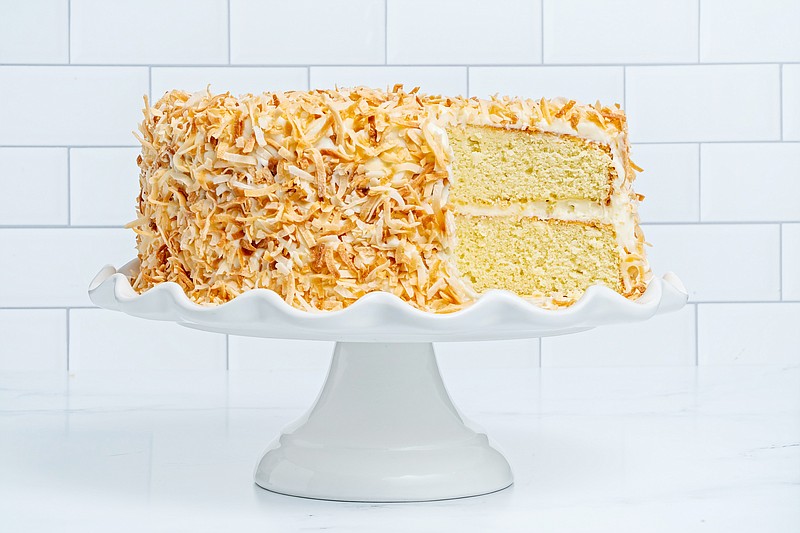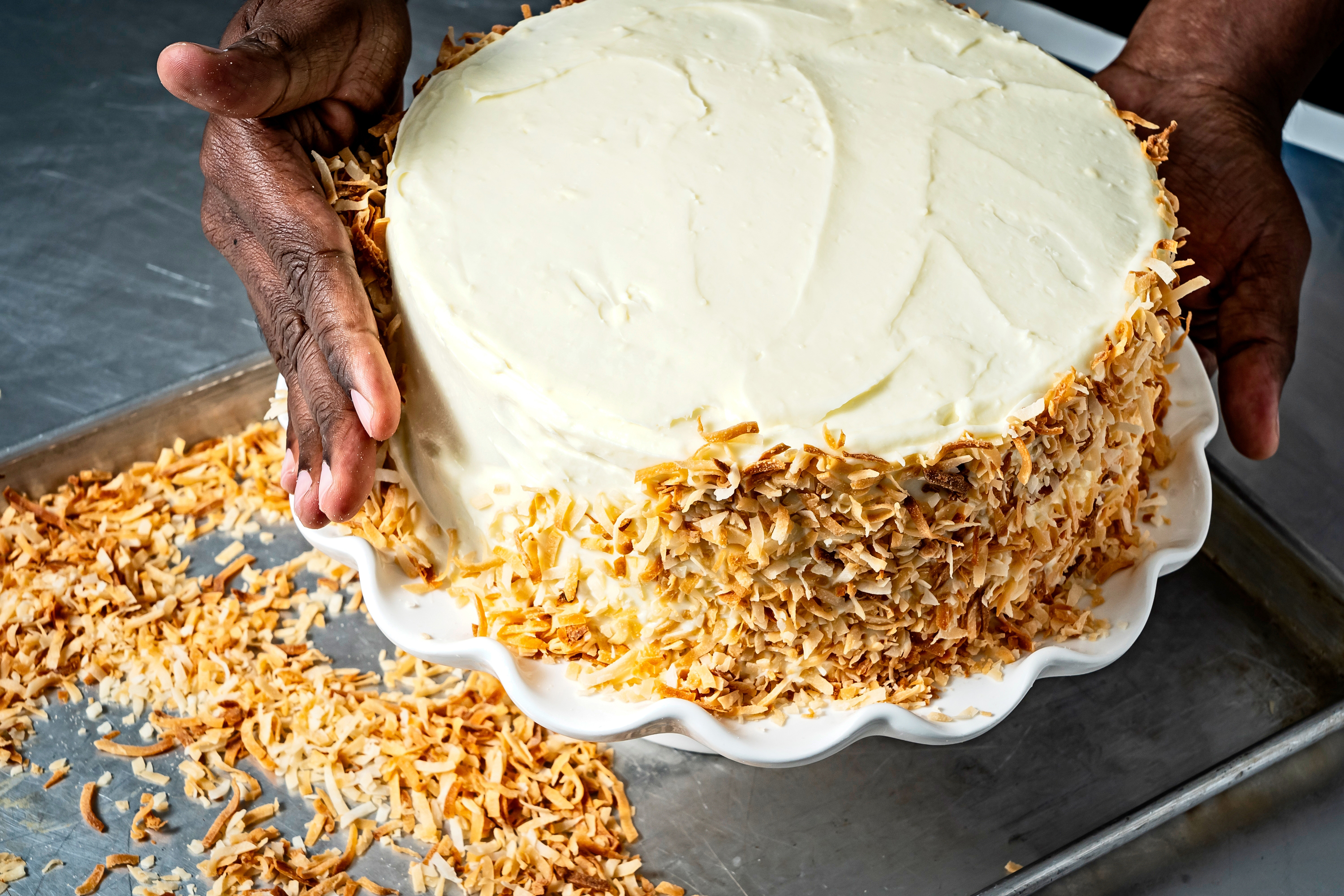Coconut cake is highly revered in soul food and Southern cuisines. Associated with celebrations and gatherings large and small -- Easter, cookouts, post-church suppers and Sunday dinners -- it typically features dense, moist layers of white cake coated with frosting and then covered with grated coconut. Having existed in some form or fashion since at least the 19th century, coconut cake is "nostalgic, but also timeless," says baker and cookbook author Cheryl Day.
"Especially in the Black community, there's going to be a coconut cake on that table if there's some gathering. It's one of those desserts that's held in high esteem," Day says. "A big memory for me are the tables when I would go see my grandmother and how the cakes would just be displayed in such grandeur."
Though she grew up in Los Angeles, Day spent her summers in Alabama with her grandmother since around the age of 8, and coconut was one of the first cakes she learned to bake. "In my family, you would always look forward to whoever was making that cake," because each person's cake had its own unique flair.
There is no one "authentic" recipe for coconut cake. "For its base, cooks followed one of several butter cake formulas, each adapted well to all sorts of flavorings, toppings, and frostings, limited only by the baker's imagination," Tipton-Martin states in "Jubilee."
"Basically, you just want a really moist, delicate crumb," Day says. "I'm constantly experimenting."
In the recipe below, which is an update of one I developed a few years ago, I call for coconut oil, coconut milk and shredded coconut to all go into the batter. Similar to Parks, I use a mix of butter and coconut oil as the fat. Make sure to use unrefined (sometimes labeled virgin or pure) coconut oil for the most flavor.
The batter bakes into deliciously dense, moist layers. One note: Do not rely on appearances when checking for doneness, as they can be deceiving. The cake layers may still look wet on the top even though they are fully baked, so it's important to use a skewer or cake tester. Even if the cake does spend a few more minutes in the oven, you will still be pleased with the
result. But if for some reason it does dry out, some bakers brush the layers with simple syrup or coconut milk (in the case of Day) for extra moisture.
Triple Coconut Cake
Active time: 30 minutes Total time: 3 hours, 30 minutes
12 to 14 servings (makes one 8- or 9-inch cake)
Coconut cake is a staple of Southern and soul food cuisines, served at celebrations and gatherings large and small. Sometimes it is as simple as a vanilla cake coated in shredded coconut, but this recipe also includes coconut milk and oil for a coconut trifecta. A tangy cream cheese frosting provides some relief from the sweet cake, and you can toast the coconut used to decorate the cake to give it a crisp texture and add a hint of nuttiness.
Make Ahead: Cake layers can be baked up to 3 days in advance. Allow them to cool completely before tightly wrapping and refrigerating. The cake layers may also be frozen, tightly wrapped, for up to 3 months.
Storage: Leftover cake may be stored, wrapped airtight or in a covered container, in the refrigerator for up to 3 days. Leftover cake can also be placed in the freezer, uncovered, until firm before tightly wrapping and storing in the freezer for up to 3 months.
NOTE: You may also bake the cakes in two 9-inch pans, but the layers will be somewhat shorter and you may need to reduce the baking time.
FOR THE CAKE
Nonstick baking spray with flour
2 1/2 cups (313 grams) all-purpose flour
2 teaspoons baking powder
1/2 teaspoon fine salt
1 cup (240 milliliters) unsweetened full-fat coconut milk
1 teaspoon vanilla extract
2 cups (400 grams) granulated sugar
3/4 cup (170 grams) unrefined coconut oil, at room temperature
8 tablespoons (1 stick/113 grams) unsalted butter, softened but cool to the touch
5 large eggs, at room temperature
One (7-ounce/198-gram) bag sweetened shredded coconut, divided
FOR THE FROSTING
Two (8-ounce/227-gram) packages full-fat cream cheese, at room temperature
16 tablespoons (2 sticks/227 grams) unsalted butter, softened but cool to the touch
1 teaspoon vanilla extract
1/4 teaspoon fine salt
One (1-pound/453-gram) box confectioners' sugar (3 2/3 cups)
Make the cake: Position a rack in the middle of the oven and preheat to 350 degrees. Coat two 8-inch cake pans with baking spray, line the bottoms with parchment paper and set aside (see NOTE).
In a medium bowl, sift together the flour, baking powder and salt. In a 2-cup liquid measuring cup or small bowl, combine the coconut milk and vanilla extract.
In the bowl of a stand mixer fitted with the paddle attachment -- or, if using a hand mixer, in a large bowl -- combine the sugar, coconut oil and butter. Beat on medium speed until light and fluffy, 3 to 5 minutes, stopping to scrape down the sides and bottom of the bowl to ensure the mixture is evenly creamed.
Reduce the mixer speed to medium-low and add the eggs, one at a time, beating until each is emulsified into the batter before adding another. Scrape down the sides and bottom of the bowl as needed, and after the last egg is added, mix until no streaks remain, but no longer than an additional 20 seconds to avoid beating too much air into the batter.
With the mixer on low speed, slowly add about a third of the flour mixture, followed by half of the coconut milk mixture, another third of the flour mixture, and then the remaining coconut milk mixture, stopping to scrape down the sides and bottom of the bowl as needed to make sure everything is evenly mixed. Add the remaining flour mixture and mix until just a bit of the flour mixture remains unincorporated. (The order is dry-wet-dry-wet-dry.) Remove the bowl from the mixer, add 1/2 cup (45 grams) of the shredded coconut and, using a rubber spatula, fold the batter, ensuring it is evenly mixed and no dry pockets of flour mixture or lumps remain. Do not overmix, or your cake will be dense and tough.
Divide the batter between the cake pans; each pan should get about 750 grams of batter. Using a small offset spatula or spoon, level the batter in each pan. Grasp each pan by the rim on opposite sides, lift it up about 3 inches and drop it onto the counter 2 or 3 times to release any large air bubbles. Bake in the oven for 35 to 45 minutes, or until a cake tester or toothpick inserted in the middle of the cakes comes out clean. (If planning to toast the coconut, keep the oven on.)
Let the cakes cool in their pans on a wire rack for 20 minutes, then run a thin knife or spatula around the edge and gently invert onto a wire rack. Remove the pans and let the cakes cool, upside-down, completely (at least 2 hours), before frosting.
Toast the coconut (optional): While the oven is still at 350 degrees, spread out the remaining coconut on a parchment-lined large, rimmed baking sheet and bake for 6 to 8 minutes, or until golden brown, stirring every 2 minutes.
Make the frosting: In the bowl of a stand mixer fitted with the paddle attachment -- or, if using a hand mixer, in a large bowl -- combine the cream cheese, butter, vanilla and salt. Beat on medium to medium-high speed until well combined and fluffy, about 1 minute. Turn the mixer off and add 1 cup of the confectioners' sugar. Starting on low speed and increasing to medium, beat to combine, then turn the mixer off. Add the remaining confectioners' sugar, 1 cup or so at a time, and beat, starting on low and increasing to medium, until the frosting is fluffy and is thoroughly combined, 1 to 2 minutes, scraping down the sides and bottom of the bowl as needed. Cover and refrigerate the frosting until ready to use, if necessary.
Assemble the cake: If the frosting has stiffened, beat it briefly, by hand or using the paddle attachment on your mixer, until it's fluffy and spreadable. Lay one cake layer on a plate or platter and top with 1 1/2 cups of the frosting. Spread the frosting into an even layer, then top with the second cake layer. Coat the top and sides of the cake with the remaining frosting. Coat the cake all over with the shredded coconut.
Nutrition information per serving, based on 14 Calories: 834; Total Fat: 53 g; Saturated Fat: 38 g; Cholesterol: 152 mg; Sodium: 370 mg; Carbohydrates: 85 g; Dietary Fiber: 1 g; Sugar: 66 g; Protein: 8 g
This analysis is an estimate based on available ingredients and this preparation. It should not substitute for a dietitian's or nutritionist's advice.
Recipe from Aaron Hutcherson


